8 Game-Changing Tips on How to Increase Employee Engagement
I’m afraid I’ve got some bad news for you — data suggests that employee engagement in the U.S. is seriously dropping. To paraphrase, this means something is amiss in American companies and they better act fast on how to increase employee engagement.
A decline in employee interest can be catastrophic, spreading from marketing to HR to the C-suite. Companies operate like living organisms, and only when the threat is eliminated from every cell, the body will heal. That’s exactly why employee engagement is so important.
In this article, I will demonstrate the main reasons why your company might be experiencing a drop in employee engagement, and what the consequences are from it. No worries, though, I’ll also demonstrate the steps you can take to fix employee engagement problems both immediately and long-term.
Let’s dive in.
The Misconceived Link Between Employee Feedback and Hiring Replacements
This right here is what many companies are doing wrong - treating employees like they’re easily replaceable. The truth is, they are - everyone’s replaceable. But it costs way more to carry out the replacement than to fix the problem.
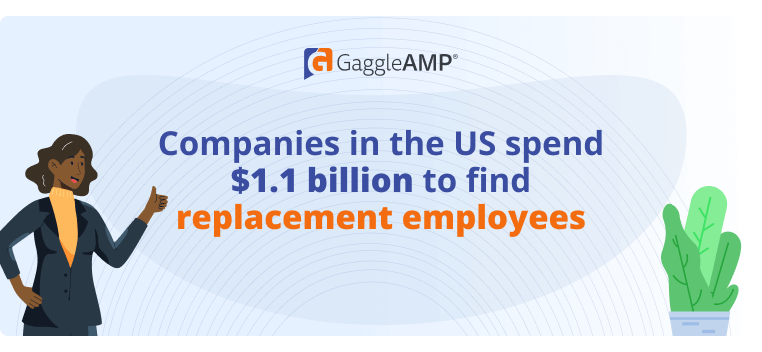
According to statistics, U.S. companies spend a head-spinning $1.1 billion every year on finding replacement employees. When you think about it, your employees might not be so easily replaceable after all.
Employees leave their companies when they are not treated fairly, and quite often the reasons aren’t financial. The paycheck can be great, but if the team leader doesn’t respect employees’ time off, or the management doesn’t dedicate time to employees’ wellness or socialization, it can feel as if the employee isn’t being heard or respected and that leads to turnover.
Those employees soon start feeling unappreciated and burnt out. Translation: they start looking for a new workplace that will offer them better satisfaction.
You’ll waste time, money, and effort to find a replacement for each and every employee who leaves you. Statistics say that it costs 33% of an entry-level employee's yearly salary when they exit. And if one employee feels they were not treated correctly by the company, chances are that there are a few others who feel the same way. If you multiply your expenses by the number of people who are thinking of leaving (or already left), then you have a serious threat to your budget.
A Dangerous Team: The Not Engaged and the Disengaged Employees
When a person isn’t motivated to do their job they become bored, not engaged, or - worse - a disengaged employee. Not engaged employees are those who do their job but don’t really care about it because they no longer can relate to it.

Source: Fisher Investments
Disengaged employees are those who are not happy with their job and don’t want to stay there, thus (un)consciously sabotaging the company by creating a toxic environment and spreading negativity.
There are two problems arising here:
- The time, money, and resources that will be wasted in finding new employees.
- Skilled employees can also be disengaged employees, but without them, you’re missing a valuable skill set needed to drive your business forward.
Negative employee experience directly affects customer experience - and with that, your company’s profitability.
That’s why one of your management’s top priorities should be introducing employee engagement strategies that can help your company increase employee engagement. But is your management aware of that responsibility?
The Myth of the Manager Who Thought Employee Engagement And Communication Were Not Part of His Job
Remember that difference between a boss and a leader - where the boss gives out orders and rules with an iron fist, while the leader helps employees grow and highlights their best assets?
A good manager is aware that employees’ happiness is crucial to their engagement and it’s his job to motivate them. A bad one just hands it over to HR because how to measure or how to increase employee engagement is not in his job description.
If you have a manager who is only interested in results and believes that the goal justifies the means, it will be almost impossible to get employees engaged in any company’s activity. In fact, statistics on managers' roles state that an astonishing 89% of decision-makers believe that employees leave their jobs just for the money and nothing else. They fail to believe that they could be the reason that employees are moving on.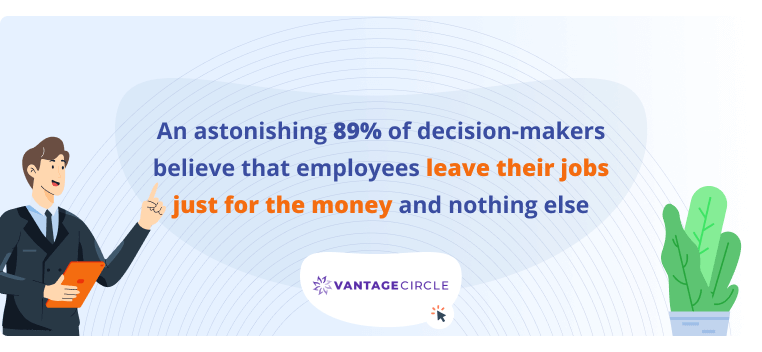 When the manager doesn’t feel obligated to work on establishing good relationships with the team, the feeling quickly becomes mutual. Teams begin entering the category of a not engaged employee. And since the devil loves idle hands, in time, non-engaged apathy can turn into disengaged anger.
When the manager doesn’t feel obligated to work on establishing good relationships with the team, the feeling quickly becomes mutual. Teams begin entering the category of a not engaged employee. And since the devil loves idle hands, in time, non-engaged apathy can turn into disengaged anger.
Luckily, the boss is not the enemy, and in reality, employees want a well-built relationship with their manager. They want to see a friend in their manager, somebody who genuinely cares about what they have to say.
To increase employee engagement and secure it in the long run, it’s best to invest in training your executive team on the importance of employee engagement and how to encourage it. It will cost you far less than investing in a new staff.
I think I’ve given you enough dreadful points on the dangers of employee disengagement. Let’s see now how you can easily avoid this dark scenario by following the proven steps below.
How to Increase Employee Engagement and Attract Customers One Step at a Time
By now it should be clear that the success of your company relies on well-established relationships among your employees. People love to have a purpose when they work. They want their work to be meaningful and feel like they are on a personal development journey even at the workplace.
We’re all sociable creatures and need to be part of a group. One recipe for successful employee motivation and engagement is to:
Create a work culture where people will feel empowered, have a sense of belonging, and get opportunities for professional growth.
Take a look at how Maslow’s pyramid of needs can directly relate to the level of employee engagement:
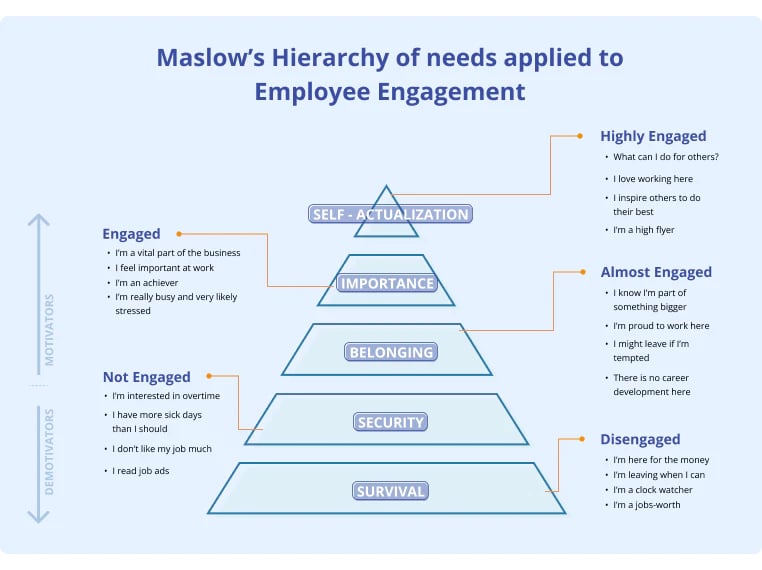
Source: The Stress Management Society
Creating a strategy for increasing engagement isn’t even that complicated - once you have the right template, it’s all about following it.
Let’s start with these 8 powerful drivers of employee engagement:
1. Let Your Employees Know What the Company Is All About
Clearly define the company’s mission statement and core values. Then connect that statement with employees' values so they will have a reason to care. They will know that there’s a meaning behind their work and will feel more related to your organization if they see the company culture going for a societal impact. And if you manage to show them how their work is closely related to the company’s purpose, you’ll witness engagement levels skyrocket.
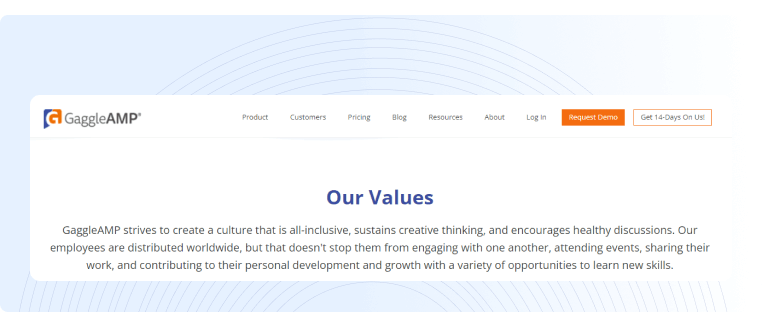
2. Everyone in the Right Place
It’s usually Einstein who’s credited with the famous saying: “If you judge a fish by its ability to climb trees, it will live its all life believing that it is stupid.” This couldn’t be more adequate when it comes to putting the right people in the right roles within the company from the very beginning.
Give them a clear definition of their role and what you expect from them. Offer professional development and career opportunities in the form of training or coaching - especially for new hires, recently promoted, and even more demanding positions within your company. When you leverage employee engagement best practices like this one, you’ll secure quality output from your employees in the long run.
When the company cares about employees’ individual career paths and personal growth, the percentage of employee retention wildly surpasses that of employee turnover - not to mention the levels of engagement.
3. Make Employees' Well-being Your Priority
Physical and mental health are key drivers of employee satisfaction and willingness to engage. In fact, the connection between employee engagement and wellness is so strong that highly engaged teams can raise profit by 21%.
Caring for your employees’ well-being doesn’t have to be anything budget crippling. How to increase employee engagement is a question with an answer as simple as providing healthy snacks and drinks in the fridge or breaks during the day to decompress.
If your employees serve the desk gods, make sure they have breaks to stretch and move around. It can be something extremely simple like sharing a YouTube video of a 6-minute yoga stretch at the office or bringing your pooch to work.
 4. Simplify Their Work Process
4. Simplify Their Work Process
Make it as easy as possible for them to do their job. Inefficient processes waste almost a third of employees’ time, so make sure you simplify wherever you can.
For example, cut down the bureaucracy - don’t drown them in papers just for the sake of filling out forms that nobody will read. Provide them with tools that will help them work faster. Use modern technology. The idea is to uncomplicate the additional tasks and keep them on track with the main ones.
5. Create a Positive Company Culture
Get to know employees on a deeper level. Create opportunities for them to get to know each other better. We all have different hobbies and interests - show interest for the individual.
Socializing outside the workplace will improve communication and strengthen team spirit, which in turn, will improve employee engagement at work. If they are having fun, they will share that on their social media.
Make work more enjoyable and less stressful for them. This can be in the form of group activities like the example above.
For others, flexible working hours are a must. Our Director of Marketing, Michelle Brammer, says flexible hours are what allows her to be present when it matters most, both at work and at home.
“We’re a fully remote company but I am often 2-3 hours removed from most of my east coast team. The flexible work hours allow me to start my day before my school-aged kids are out of bed, knocking out early east-coast meetings and email, but still be available to take them to school and get them off the bus. It might sound like something so small, but trust me when I say it means the world to a working parent.”
If, however, the type of work doesn’t allow a flexible working schedule, something like one Friday off per month can help employees decompress and better balance their work and home life.
The better the balance between their work and personal life, the greater the motivation and the level of engagement.
6. Ask For Their Opinion
Who doesn’t want their voice to be heard? If an employee feels like they’re being heard on a personal level, they will want to give more in return.
This is a really simple step you can take effortlessly. Create an online employee survey and share it with your employees to collect relevant data about your company. Make the survey anonymous, so they feel comfortable giving honest answers.

Focus on getting employee feedback and learning how to improve the organization and increase employee engagement. If leaders in your company show genuine interest in what their employees think and how to improve their overall experience, employees will willingly work toward reaching the company’s business goals.
7. Give Employee Feedback
It’s only fair to give the same thing you asked for, right? The only difference here is that you shouldn’t wait just for the official yearly reports to check in on your team. While official feedback is a must, unofficial follow-up can offer invaluable insight into the real state of things.
When you give feedback, put the focus on the employees’ strengths and purpose. Boosting confidence is extremely important because employees don’t want to do a task for which they lack confidence.
Of course, address any issue that needs to be tackled, but do it in a way that will empower the person - not make them crawl back into their shell. This way they will feel greater trust in you as a leader and the company as a whole.
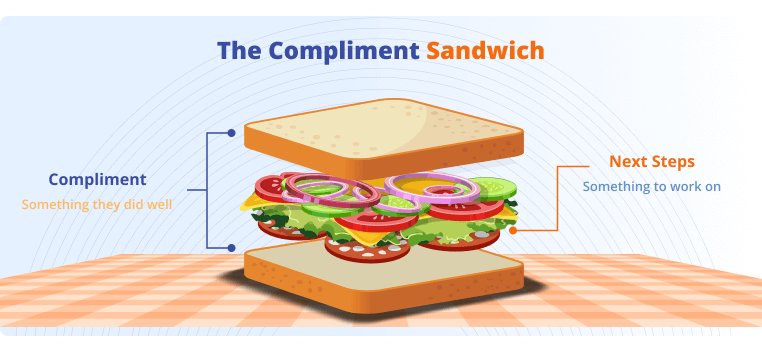
One way of giving feedback is with the concept of the ‘Compliment Sandwich.’
8. Recognize and Appreciate
What way better to increase employee engagement than through recognition and prizes? I’m sure it would make your day much brighter if your team came into your office right now with a big Hershey bar and a mug with World’s #1 boss written on it.
Imagine the pride and joy of the employee getting recognized and appreciated by their company. Think about it — they might text a loved one what happened but then they’ll likely take to social media to share the exciting news, and so will those dishing out the awards. Talk about a greater reach of audience, right? And who wouldn’t want to work for an organization that actually sees, hears, and appreciates its employees?
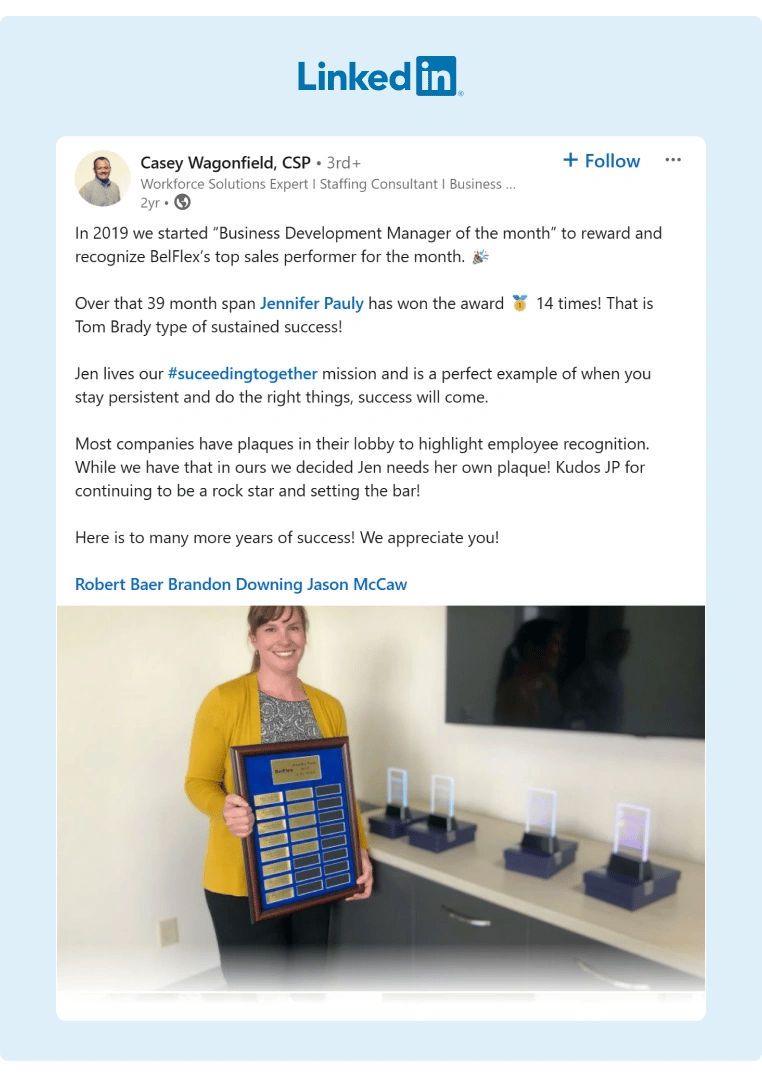
One of the best employee engagement ideas you can incorporate related to giving recognition is gamification. Add a little competitive spirit to the workplace. People love some healthy competition - it motivates them to engage in a fun way.
An example of the leaderboard in the GaggleAMP employee advocacy platform.
You can also hold a competition for some healthy activity like reaching 10,000 steps daily, encouraging teams to battle for extra days off, or even swag gifts like t-shirts, bottles, keychains, and more.
There are a number of employee engagement activities you can use and adapt to best fit your company culture. Just make sure you publicly display your employees’ achievements and the rewards for them.
Let’s Summarize
Disengaged employees can and will cost you. Nobody wants to stay at a company that doesn’t recognize their efforts, doesn’t care about their well-being, or is just ignorant of their personal struggles.
If you want to scale your business or strengthen your brand, even more, engaged employees are one of your most powerful assets. Take care of them so they have more time and more motivation to be your brand ambassadors.
To learn how to increase employee engagement, start by incorporating these steps into your employee engagement strategy. Some can be done immediately, for others it takes time. You win in both cases, as long as your company’s mission and culture are in the same lane as your employees’ values.









